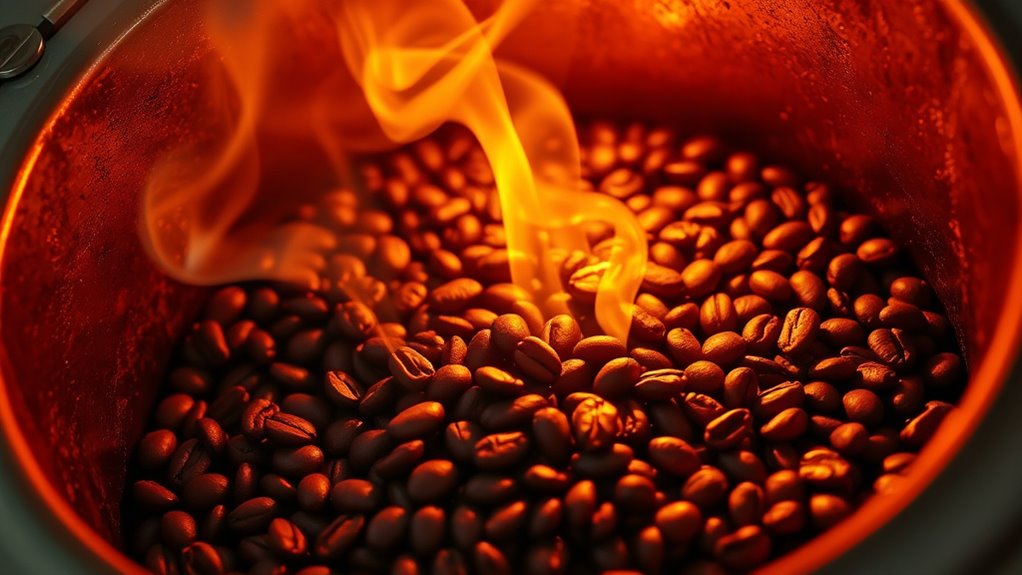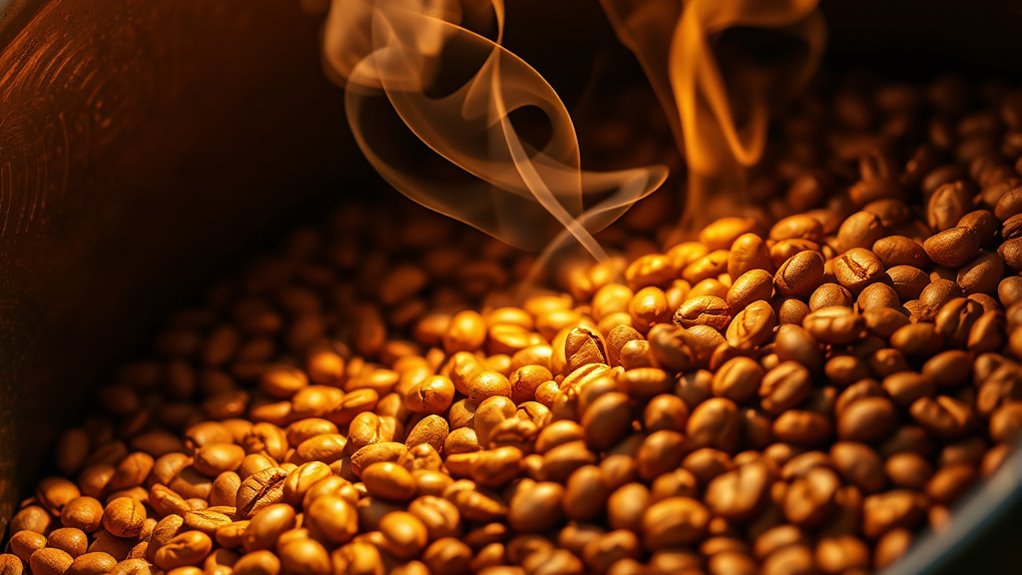When you roast coffee beans, heat causes essential chemical reactions that develop their flavor, aroma, and color. Initially, moisture evaporates, and chlorophyll breaks down, changing the bean’s hue. As temperatures rise, Maillard reactions create complex flavors and caramelization enhances sweetness. The first and second cracks signify stages of expansion and surface oils. Rapid cooling halts these transformations, preserving the desired profile. Explore further to understand how each step shapes your perfect cup.
Key Takeaways
- Heat causes chemical reactions like Maillard and caramelization, developing coffee’s aroma, flavor, and color.
- Moisture evaporation and chlorophyll breakdown change bean appearance from green to yellow or gray.
- Temperature stages trigger first and second cracks, indicating roast levels and flavor development.
- Elevated heat increases bean porosity, enhancing flavor extraction and aroma release during brewing.
- Rapid cooling halts reactions, preserving volatile aromatics and ensuring a uniform, desirable roast profile.

Understanding the science behind coffee roasting reveals how heat transforms green beans into the aromatic, flavorful brew we enjoy. When you apply heat to green coffee beans, you’re triggering a series of chemical reactions that convert raw seeds into the complex, fragrant beans we recognize as roasted coffee.
Industrial roasters typically use drum or hot air systems to distribute heat evenly, ensuring a consistent roast. Initially, as heat penetrates the beans, moisture is driven out through evaporation during the drying phase. This step not only prevents uneven roasting and scorching but also causes chlorophyll within the beans to break down, changing their color from green to yellow or gray. Temperature control during this phase is essential; too much heat risks burning flavors, while too little results in underdeveloped profiles.
As the temperature rises, the Maillard reaction kicks in between 284–329°F (140–165°C). This key process involves amino acids reacting with reducing sugars, producing melanoidins and aromatic compounds that form the rich, brown coloration and complex aroma of roasted coffee. The duration of this reaction influences flavor depth: a longer Maillard phase enhances caramelization and sweetness, while rushing it can leave the coffee grassy or bread-like. Overcooking during this stage creates bitterness, so maintaining an even temperature is fundamental to avoid disrupting the browning process.
When temperatures reach 338–374°F (170–190°C), caramelization occurs. Sucrose breaks down into simpler sugars and organic acids, boosting the coffee’s sweetness and body. This step also releases CO₂, which helps expand the beans and creates porosity that affects flavor extraction during brewing. Proper caramelization balances acidity by transforming chlorogenic acids into milder compounds, adding to the overall flavor complexity. However, overdoing it can lead to burnt or charred notes that diminish quality.
The first crack happens around 385–390°F (196–199°C). As vapor pressure fractures the bean’s cellulose structure, you’ll hear a distinct pop. The beans double in size, lose 10–15% of their weight, and become porous and brittle. This marks the transition from a light to a medium roast, preserving many of the beans’ origin-specific flavors. Roasters often extend this phase to highlight fruity or floral notes, but immediately reducing heat afterward prevents overdevelopment.
Approaching 437–446°F (225–230°C), the second crack signals a darker roast. Sharp cracking sounds occur as oils migrate to the surface, giving the beans a glossy appearance and developing smoky, bittersweet flavors. The cellulose matrix collapses, reducing acidity, but there’s a risk of over-roasting, leading to ashy or burnt tastes.
Once the desired roast level is achieved, rapid cooling, usually by air or water quenching, halts chemical reactions instantly. This step is essential to locking in volatile aromatics and maintaining even texture. Cooling within 4–6 minutes prevents residual heat from continuing the roast, ensuring consistency.
The entire process is highly customizable, with variables like temperature curves, airflow, batch size, and duration shaping the final profile. Understanding how heat influences each stage allows you to craft a roast that highlights the beans’ unique characteristics and flavors. Proper temperature control is crucial for achieving consistent and high-quality roasts.
Frequently Asked Questions
How Does Altitude Affect Coffee Roasting Temperatures?
Altitude affects your coffee roasting temperatures because higher elevations have less oxygen and moisture, requiring you to use more heat to achieve the same roast. The thinner air at altitude means you’ll need to adjust your temperature carefully, often increasing it, but watch out for over-roasting.
Temperature control becomes essential since lower oxygen levels can change how beans develop, making precision indispensable for a consistent, quality roast.
Can Different Bean Varieties Influence Heat Transfer During Roasting?
Different bean varieties do influence heat transfer during roasting. You’ll notice that dense beans, like high-altitude Arabicas, need more energy and precise heat control to guarantee even roasting.
In contrast, lower-density beans, such as Robusta, heat up faster and can scorch easily if you’re not gentle. Adjusting your roasting profile based on bean type helps you achieve consistent results and highlights the unique flavors each variety offers.
What Role Does Humidity Play in Roasting Consistency?
You might think humidity doesn’t matter much, but it actually plays a vital role in roasting consistency. High humidity boosts heat transfer efficiency, helping you achieve even roasts, yet can slow color development and mute brightness.
Low humidity speeds up processes but increases the risk of uneven roasting or scorching. Adjusting your profile based on humidity levels guarantees uniformity, preventing defects caused by moisture-related fluctuations.
How Do Roasting Techniques Impact Caffeine Levels?
Roasting techniques don’t substantially impact caffeine levels, since caffeine remains stable during roasting. Your choice of roast—light or dark—mainly affects bean weight and volume, not caffeine content. If you weigh your beans, you’ll find caffeine consistent across roasts.
However, brewing methods and grind size influence how much caffeine you extract. So, focus on your brewing process rather than roasting techniques to control caffeine intake.
Are There Specific Heat Sources That Produce Better Flavor Profiles?
Think of heat sources like chefs in a kitchen—each brings a unique flavor to the dish. Infrared heat, for example, penetrates beans deeply, preserving delicate flavors and speeding up roasting, resulting in vibrant, complex profiles.
Convection heats evenly, highlighting brightness and clarity.
Hybrid systems combine methods for balanced, nuanced flavors.
Your choice depends on the profile you desire; experimenting helps you discover which heat source produces your perfect cup.
Conclusion
As you roast your beans, remember that every degree of heat shapes their flavor. Imagine a small café experimenting with roasting temperatures—raising the heat slightly might unbolt a richer, caramelized profile, delighting customers even more. By understanding the science behind heat transformation, you can fine-tune your process for perfect results. So, keep experimenting and observing—your next great coffee masterpiece is just a roast away!









